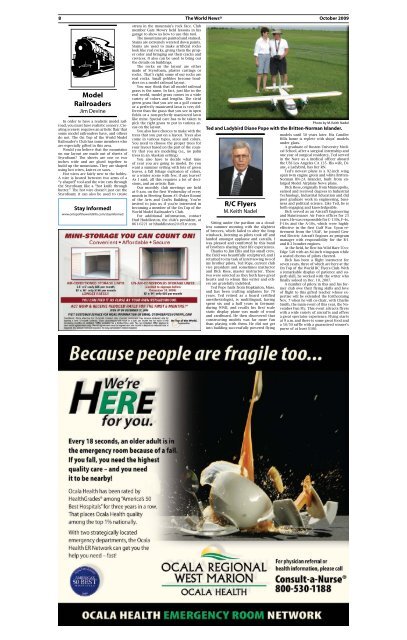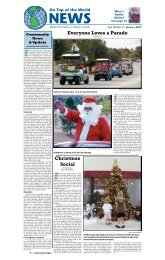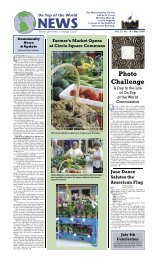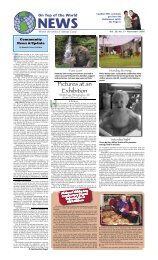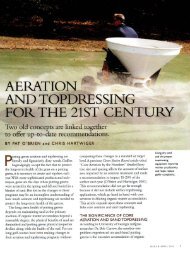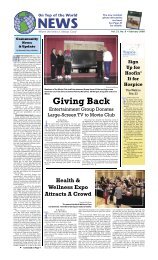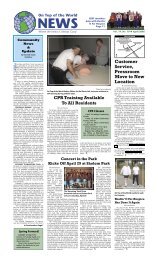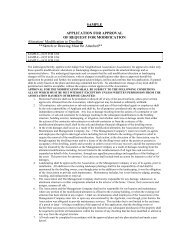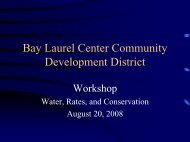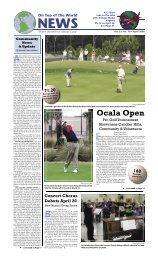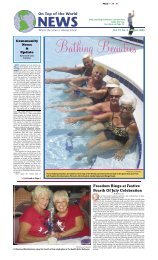8 The <strong>World</strong> News® <strong>October</strong> <strong>2009</strong>ModelRailroadersJim DevineIn order to have a realistic model railroad,you must have realistic scenery. Creatingscenery requires an artistic flair thatsome model railroaders have, and o<strong>the</strong>rsdo not. The <strong>On</strong> <strong>Top</strong> <strong>of</strong> <strong>the</strong> <strong>World</strong> ModelRailroader’s Club has some members whoare especially gifted in this area.Would you believe that <strong>the</strong> mountainson our layout are made out <strong>of</strong> sheets <strong>of</strong>Styr<strong>of</strong>oam? The sheets are one or twoinches wide and are glued toge<strong>the</strong>r tobuild up <strong>the</strong> mountains. They are shapedusing hot wires, knives or saws.Hot wires are fairly new to <strong>the</strong> hobby.A wire is heated between two arms <strong>of</strong> a“y-shaped” tool and <strong>the</strong> wire cuts through<strong>the</strong> Styr<strong>of</strong>oam like a “hot knife throughbutter.” The hot wire doesn’t just cut <strong>the</strong>Styr<strong>of</strong>oam; it can also be used to createStay <strong>Info</strong>rmed!www.ontop<strong>of</strong><strong>the</strong>worldinfo.com/stayinformedstrata in <strong>the</strong> mountain’s rock face. Clubmember Gary Mowry held lessons in hisgarage to show us how to use this tool.The mountains are painted and stained.Stains are extremely watered down paints.Stains are used to make artificial rockslook like real rocks, giving <strong>the</strong>m <strong>the</strong> propercolor and bringing out <strong>the</strong>ir cracks andcrevices. It also can be used to bring out<strong>the</strong> details on buildings.The rocks on <strong>the</strong> layout are ei<strong>the</strong>rmade <strong>of</strong> Styr<strong>of</strong>oam, plaster castings orrocks. That’s right; some <strong>of</strong> our rocks arereal rocks. Small pebbles become boulderson a model railroad layout.You may think that all model railroadgrass is <strong>the</strong> same. In fact, just like in <strong>the</strong>real world, model grass comes in a widevariety <strong>of</strong> colors and lengths. The vividgreen grass that you see on a golf courseor a perfectly manicured lawn is very differentthan <strong>the</strong> grass that you see in openfields or a non-perfectly manicured lawnlike mine. Special care has to be taken topick <strong>the</strong> right grass to put in various areason <strong>the</strong> layout.You also have choices to make with <strong>the</strong>trees that you put on a layout. Trees alsocome in various types, sizes and colors.You need to choose <strong>the</strong> proper trees foryour layout based on <strong>the</strong> part <strong>of</strong> <strong>the</strong> countrythat you are modeling (i.e., no palmtrees in an Alaskan setting).You also have to decide what time<strong>of</strong> year you are going to model. Do youwant a summer setting with lots <strong>of</strong> greenleaves, a fall foliage explosion <strong>of</strong> colors,or a winter scene with few, if any leaves?As I said, all this requires a lot <strong>of</strong> decisions,and an artistic flair.Our monthly club meetings are heldat 9 a.m. on <strong>the</strong> first Wednesday <strong>of</strong> everymonth in Meeting Room #3 (Poker Room)<strong>of</strong> <strong>the</strong> Arts and Crafts Building. You’reinvited to join us if you’re interested inbecoming a member <strong>of</strong> <strong>the</strong> <strong>On</strong> <strong>Top</strong> <strong>of</strong> <strong>the</strong><strong>World</strong> Model Railroader’s Club.For additional information, contactHud Huddleston, <strong>the</strong> club’s president, at861-6221 or hhuddleston2@cfl.rr.com.Photo by M. Keith NadelTed and Ladybird Diane Pope with <strong>the</strong> Britten-Norman Islander.R/C FlyersM. Keith NadelSitting under <strong>the</strong> pavilion on a cloudlesssummer morning with <strong>the</strong> slightest<strong>of</strong> breezes, which failed to alter <strong>the</strong> limpwindsock, listening as pilots took <strong>of</strong>f andlanded amongst applause and catcalls, Iwas pleased and comforted by this band<strong>of</strong> bro<strong>the</strong>rs sharing <strong>the</strong>ir life experiences.Thanks to Jim Ellis and his small crew,<strong>the</strong> field was beautifully sculptured, and Ireturned to my task <strong>of</strong> interviewing two <strong>of</strong>my bro<strong>the</strong>r pilots, Ted Pope, current clubvice president and sometimes instructorand Dick Rose, master instructor. Thesetwo were selected as <strong>the</strong>y both have grea<strong>the</strong>arts and to whom this writer and o<strong>the</strong>rsare gratefully indebted.Ted Pope hails from Hopkinton, Mass.and has been crafting airplanes for 70years. Ted retired as a board certifiedanes<strong>the</strong>siologist, is multilingual, havingspent six and a half years in Germanyduring WWII, and recalls his first scalestatic display plane was made <strong>of</strong> woodand cardboard. He <strong>the</strong>n discovered thatconstructing models was far more funthan playing with <strong>the</strong>m. He did not getinto building successfully powered flyingmodels until 50 years later. His CandlerHills home is replete with ships’ modelsunder glass.A graduate <strong>of</strong> Boston University MedicalSchool, after a surgical internship andone year <strong>of</strong> surgical residency, Ted servedin <strong>the</strong> Navy as a medical <strong>of</strong>ficer aboard<strong>the</strong> USS Los Angeles CA 135. His wife, Diane,a Ladybird, has her RN.Ted’s newest plane is a 92-inch wingspan twin engine green and white Britten-Norman BN-2A Islander, built from enlargedModel Airplane News plans.Dick Rose, originally from Minneapolis,earned and received degrees in IndustrialTechnology, Industrial Education and didpost graduate work in engineering, businessand political science. Like Ted, he isboth engaging and knowledgeable.Dick served as an Aircraft Engineeringand Maintenance Air Force <strong>of</strong>ficer for 23years. He was responsible for C-130s, F-4s,F-16s and <strong>the</strong> A-10s, which were highlyeffective in <strong>the</strong> first Gulf War. Upon retirementfrom <strong>the</strong> USAF, he joined GeneralElectric Aircraft Engines as programmanager with responsibility for <strong>the</strong> B-1and B-2 bomber engines.At <strong>the</strong> field, he flew his Wild Hare 50 ccEdge 540 with an 84-inch wingspan whilea seated chorus <strong>of</strong> pilots cheered.Dick has been a flight instructor forseven years, three <strong>of</strong> which are here at <strong>the</strong><strong>On</strong> <strong>Top</strong> <strong>of</strong> <strong>the</strong> <strong>World</strong> RC Flyers Club. Witha remarkable display <strong>of</strong> patience and superbskill, he worked with <strong>the</strong> writer wh<strong>of</strong>inally soloed in Dec. 10, 2007.A number <strong>of</strong> pilots in this and his formerclub owe <strong>the</strong>ir flying skills and love<strong>of</strong> flight to this gifted teacher whose expertisewill be extended <strong>the</strong> forthcomingNov. 7 when he will co-chair, with CharlieSmith, <strong>the</strong> main event <strong>of</strong> this year, <strong>the</strong> NovemberFun Fly. This event attracts flyerswith a wide variety <strong>of</strong> aircrafts and <strong>of</strong>fersa great spectator experience. Flying startsat 9 a.m. and <strong>the</strong>re is some great food anda 50/50 raffle with a guaranteed winner’spurse <strong>of</strong> at least $100.
<strong>October</strong> <strong>2009</strong> The <strong>World</strong> News® 9FriendshipAmateur RadioEd BrendleThe Friendship Amateur Radio Clubheld its monthly meeting on Sept. 14 withCharles Lucus, W1DOH, presiding. Therewas a continuation <strong>of</strong> <strong>the</strong> video presentationsgiving us a greater appreciation<strong>of</strong> <strong>the</strong> efforts taken just to plan a trip tosome far away location to set up <strong>the</strong> stationsand transmit. It’s a challenge andone that takes great planning and coordination<strong>of</strong>ten resulting in bad elementsmaking <strong>the</strong> work even harder. But that’swhat us “hams” do, we’re always eager toattempt something new and not a proveneffort. When all is completed, <strong>the</strong> successbeams through and contacts were made,making all <strong>the</strong> work worthwhile.<strong>World</strong> News DeadlineE-mailed by:Noon, 13th <strong>of</strong> <strong>the</strong> month“Personal Service Since 1954”• Auto • Home • Health • Golf CartFor fast, competitive rates,please call (352) 351-31116 Carl CourtBeverly Hills, FL 34465(352) 746-558020497 E. Pennsylvania Ave.Dunnellon, FL 34432(352) 489-2412These video presentations certainly <strong>of</strong>fer<strong>the</strong> educational element. Hams are alwaysstriving to “do just one better.” Thismakes our hobby such a reward. Equipment,good transmitting conditions, andwith a great deal <strong>of</strong> patience, radio “hams”can communicate from almost any location.It emphasizes that <strong>the</strong> challenge isalways <strong>the</strong>re. When disaster strikes, it isour job to be <strong>the</strong>re communicating andcoordinating all <strong>the</strong> vital information.The club’s website continues to showboth <strong>the</strong> treasurer’s and secretary minutes.The Friendship Radio Club’s callsign is N4 FRC.The next meeting is scheduled for Oct.12 at 1:30 p.m. at <strong>the</strong> auxiliary Sheriff’sstation on West SR 200. All “hams” areinvited. Members are urged to bring aguest.A recent notation is that our club isrecognized as a SSC, Special Service Club,<strong>of</strong> which <strong>the</strong>re are only four, in <strong>the</strong> immediatearea.The FARC is open to all “hams” and<strong>the</strong>ir families. If you are interested, andnot currently licensed, <strong>the</strong> FARC has instructorswho can assist in teaching <strong>the</strong>ory,to help you earn your license.We have members who can <strong>of</strong>fer <strong>the</strong>irexpertise in radio and computers. Theclub’s website continues to inform members<strong>of</strong> <strong>the</strong> many activities being <strong>of</strong>fered.The club has a two-meter net that meetson each Monday, except for a meeting, at4 p.m. on 145.170 MHZ, (except for Monday<strong>of</strong> <strong>the</strong> monthly meeting). For additionalinformation, please call Ed Brendle,KA1INC at 873-4354.Who is <strong>the</strong>Entertainment Group?The Oct. 25 show marks <strong>the</strong> 10th anniversary<strong>of</strong> <strong>the</strong> Entertainment Group presentingpr<strong>of</strong>essional entertainment to <strong>On</strong><strong>Top</strong> <strong>of</strong> <strong>the</strong> <strong>World</strong>.The Entertainment Group’s missionstatement:• To bring pr<strong>of</strong>essional shows fromall over <strong>the</strong> country with ticketprices equaling <strong>the</strong> ticket to a firstrun movie and a box <strong>of</strong> popcorn• At <strong>the</strong> conclusion <strong>of</strong> each series(after <strong>the</strong> bills have been paid andmonies set aside for <strong>the</strong> next series),make donations to Hospice<strong>of</strong> Marion County, The Center for<strong>the</strong> Blind and Marion County SeniorServices.• To give back to <strong>the</strong> community.Some give-backs include a dressingroom, stage curtain, new stagefloor, 60-inch TV (used by <strong>the</strong>Movie Club), special lighting for<strong>the</strong> sound and light crew, furnitureand window treatments in<strong>the</strong> library, benches at <strong>the</strong> basketballcourts, folding partition in <strong>the</strong>Health & Recreation Ballroom andlighting <strong>of</strong> <strong>the</strong> mini golf course.None <strong>of</strong> <strong>the</strong> above would have everbeen possible without <strong>the</strong> support <strong>of</strong> oursponsors and <strong>the</strong> support <strong>of</strong> our residents.The Entertainment Group looksforward to seeing you on Oct. 25.www.feroinsurance.comFriendship Center at<strong>On</strong> <strong>Top</strong> <strong>of</strong> <strong>the</strong> <strong>World</strong>8441 SW SR 200, Suite 117Ocala, FL 34481(352) 351-3111ComputerClubSherry Surdam352-873-4817www.DigitalCommunicationMedia.comRENEWED ◆ SURFACESWe specialize in repairing your concrete not just coloring over it!WE MAKE YOUR CONCRETE LOOK GOOD!By Re-Surfacing Your Concrete!Driveways ◆ Pool Decks ◆ Patios ◆ Garages ◆ Entrance Ways◆ Commercial Grade Quality ◆ Easy to Keep Clean◆ Mildew & Oil Resistant◆ Non-Skid Protection◆ Many Colors!PAVERSCleaned & Clear SealedLasts for Years!Mildew & Oil ResistantBrings Out <strong>the</strong> True ColorFamily Owned & OperatedSince 1972237-2796A Division <strong>of</strong> R.C. Cohn ConstructionAs <strong>of</strong> this writing we haven’t had awhole lot <strong>of</strong> relief from <strong>the</strong> heat but “hopesprings eternal!”During September, we had a two-partpresentation on using Google’s imageeditingprogram “Picasa.” Picasa 3 is asurprisingly full-featured program wellworth checking out if you like to tweakyour photographs. Using Picasa, you canremove imperfections or unwanted objectsfrom your photos, brighten colors,crop, resize and achieve a variety <strong>of</strong> effects.Google provides a very good onlinemanual, which gives comprehensivedirections on how to edit photos to yoursatisfaction. It is totally free and fun touse.<strong>On</strong> Oct. 31, we will have a program onusing Open Office 3. Open Office is anopen-source suite <strong>of</strong> programs createdby users like you and me. Because usersdeveloped it, anyone can look at <strong>the</strong> programs,suggest improvements and reportproblems. You can even request enhancementsand someone will no doubt try tooblige. The best part…it’s totally free!<strong>On</strong> Saturday, Oct. 24 at 11:30 a.m.,we will have our Member AppreciationPicnic. This is open to all members, <strong>the</strong>irspouses and guests. The club is subsidizing<strong>the</strong> cost <strong>of</strong> <strong>the</strong> picnic for membersand <strong>the</strong>ir spouses but guests <strong>of</strong> membersare welcome. The cost for members andspouses is $5 per person and <strong>the</strong> cost forguests is $10 per person. We always havea good time, so if you are interested insocializing with us, contact a friend youknow in <strong>the</strong> club and ask <strong>the</strong>m to get youa ticket! We need to know how many willattend at least one week prior to <strong>the</strong> eventas <strong>the</strong> caterer must have a final count forhis preparation <strong>of</strong> food. We will be havingtrue picnic foods such as hot dogs, hamburgers,potato salad, etc.The initial program will focus on downloadingand installing Open Office andtake a brief look at <strong>the</strong> “Writer” withinOpen Office. “Writer” is a fully equippedword processor or desktop publisher andcan open literally any document createdby any word processor. We hope to havemore programs going into o<strong>the</strong>r portions<strong>of</strong> this wonderful suite <strong>of</strong> programs.We don’t always know in advance <strong>of</strong>submitting this column what our programschedule will be so be sure to watch <strong>the</strong>website at http://www.cccocala.org/ forinformation on upcoming programs and/or o<strong>the</strong>r changes to <strong>the</strong> schedule.All meetings are held at 9 a.m. at <strong>the</strong>Arbor Conference Center, Suites B and Con Tuesdays, Thursdays and Saturdays. Ifyou aren’t a member yet but want to seewhat we do, come on up and give us alook-see. I think you’ll find we have muchto <strong>of</strong>fer both novice and users that aremore experienced!Hope to see some new faces soon!NEW CONCRETEWe Install New orReplace Old SlabsDriveways/Drive ExtensionsPatios/WalkwaysTotal Concrete ServiceLicensed & Insured #3803Dependable


